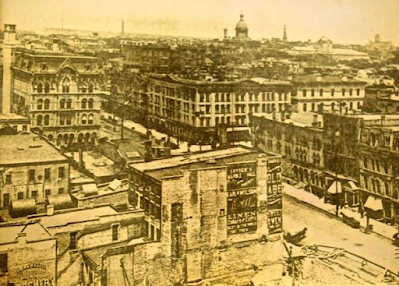Considered by many as Milwaukee’s oldest standing building, the Marble Hall wrote a distinctive story as the city’s premier saloon, gambling house, and political center of the 1800s. Located at 625 N. Broadway, the building also is associated with two major disasters, both involving significant loss of life.

Snyder, a Milwaukee liquor dealer living at 103 Seventh Street, long had looked for a place to house his dream of a high class saloon and gambling parlor. A newly constructed four story building in downtown Milwaukee had the right kind of almosphere Snyder was seeking. He moved in and quickly created the city’s premier “watering hole,” known city-wide for his famed marble bar, shown below.
It was not just the bar itself, however, but also marble and slate tiles on the floor and other orate features that drew customers. Following a fire in 2001, repairs revealed a large skylight at the rear of the saloon, decorated on the glass with pictures of plants and flowers. Also uncovered were a large pair of paintings that had flanked the bar. Indeed, Marble Hall had been a swanky drinking establishment.
Although strictly speaking a saloon, albeit one with a reputation for serving good food,Marble Hall was the name applied to the entire building. This included rooms on the second floor, a Milwaukee center for local gambling and a Wisconsin political hotspot. As one newspaper reported: “Governors and mayors rubbed elbows there…Marble Hall gambling was ‘big league.’ Huge wagers were made on every election — national, state and local. No odds were official until Marble Hall set its own.” It was the saloon downstairs, however, where political deals were made. There the fates of judges, mayors, councilmen, even governors, might be determined — and the results toasted with some of Fred Snyders’ “Old Crow “ whiskey.
Marble Hall also could be the scene of local hijinks. It was reported that a Milwaukee mayor once walked into the saloon leading a cab horse that had transported him there. Instead of displaying the typical nude over the bar, Snyder installed the portrait of a United States Senator, Matthew Hale Carpenter of Wisconsin, shown here. A gifted orator, known as the “Daniel Webster” of the West” Carpenter was a frequent patron of Marble Hall.
Marble Hall also knew its share of tragedy and sorrow. In September 1860, amid the unrest preceding the Civil War, the city experienced the greatest disaster in its history. Returning to Milwaukee from an excursion on Lake Michigan to Chicago, the steamship Lady Elgin was rammed by a fishing boat and sank. An estimated 300 passengers perished. Afterward survivors, relatives and others gathered annually at Marble Hall to commemorate the disaster.
The bodies of some victims were laid out in Marble Hall.Shown below is the saloon building having survived the firestorm. Note that the destruction of Newhall House uncovered earlier advertising on a wall of Marble Hall. By this time Fred Snyder had sold the property to the Pawlinski brothers. Although both Fred and Peter were recorded as proprietors of the Marble Hall, the former seems to have been senior partner. Fred’s name alone appears on the bottled liquor that the saloon was selling in addition to drinks over the bar.
he brothers operated their saloon well into the 1900s until closed by the advent of national Prohibition. And then beyond. As described by Milwaukee collector Henry Hecker: “ Fred W. Pawinski, got a little more publicity in 1921. He was indicted and convicted in Federal Court for illegally selling whiskey and sentenced to 11 years in Federal Prison. He was sixty-six years old at the time. Likely owing to his long association with many politicians, some highly placed, a petition was quickly circulated and presented to then President Harding. President Harding issued Fred a pardon.”
The 13 years of Prohibition were not kind to Marble Hall. A fire in 1933 required demolition of the two top floors. The saloon was closed as were the gambling spaces upstairs during and after America’s effort to go “dry.” The building subsequently held Ianelli’s upholstery shop. The address was changed to 654 Broadway. Few who pass the old building today know that it once held Milwaukee’s most elegant saloon and the center of local and state politics.










No comments:
Post a Comment